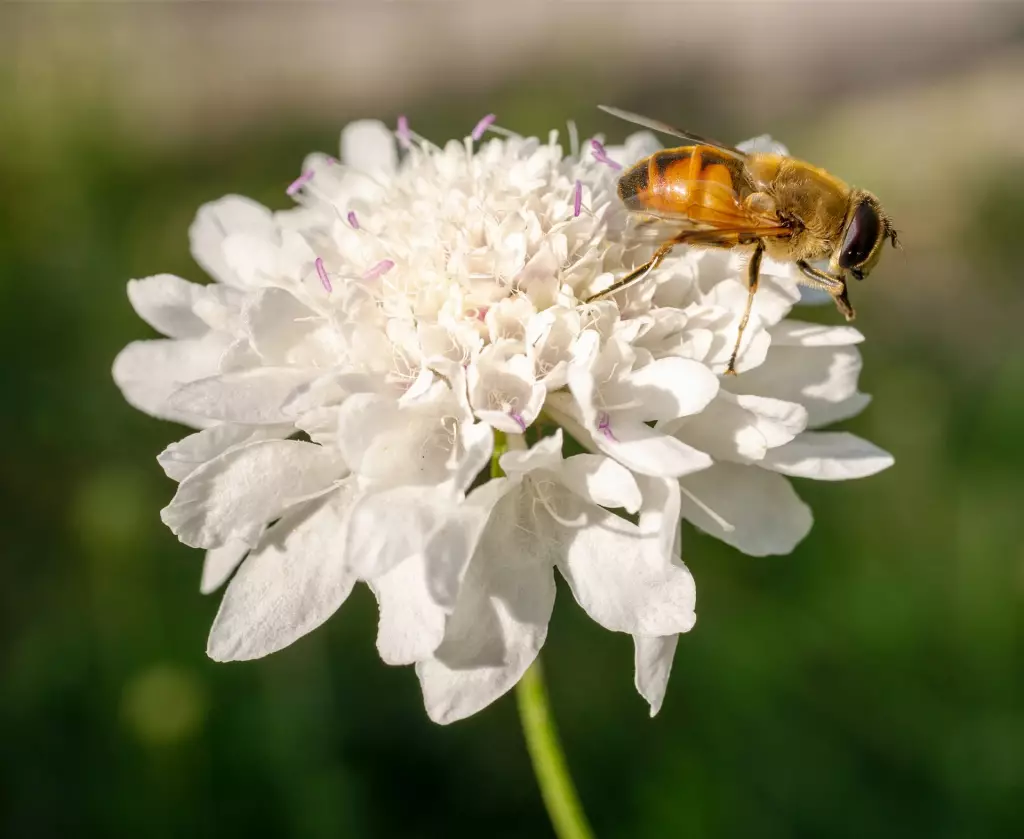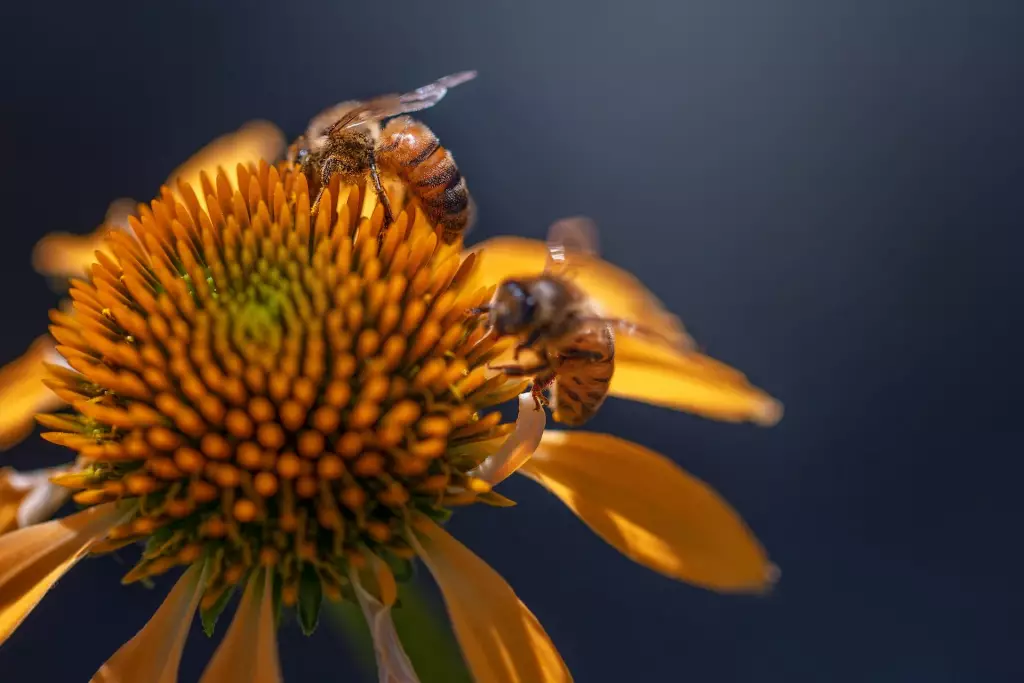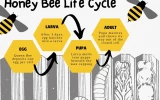What Months Do Bees Make Honey? (with Calendar)
Foraging worker honey bees collect nectar from flowers and process it to produce honey. Honey is the primary source of food for the bee colony. But do bees produce honey all year? If not, what months do they make honey?
Bees make a lot of honey during the warmer months and when flowers begin to bloom. They produce the most honey in the late spring and early summer, particularly in May and June. Honey bees spend the spring, summer, and including early fall producing and storing honey and filling honeycombs.
As freezing temperatures subside, more flowers bloom and honey bees begin to forage more actively. The abundance of nectar and pollen provided by the many flowering trees in the spring fuels a rapid increase in brood rearing and colony population.
Summary
- The nectar produced by flowers is required by bees in order to produce honey.
- Nectar flows occur in May and June when there’s an abundance of flowers like oil seed rape.
- Foraging worker bees collect nectar from flowers in warm weathers of spring and summer.

On this page:
Bees Produce the Most Honey in May and June
Honeybees do not produce honey all year round. They only produce honey while foraging in the spring and summer.
Foraging worker honey bees collect nectar from flowers within a four-mile radius of their hive in the warm weather of spring and summer.
Your bees will continue to produce honey as long as they can find nectar from flowers and have enough space in their hives to store it for ripening and use.
What beekeepers usually need to do during spring and summer is to take a step back and let the bees do their thing—make honey in peace.
Honeybees will leave their hives in search of flowers as the weather warms and flowers begin to bloom.
Bees are insects that only eat flowers. They eat a portion of the nectar they collect. The remainder is converted into honey and stored in the hive.
When food is scarce, the colony subsists on honey. Let us explore when bees produce honey.
| Spring Months | Summer Months | Fall Months | Winter Months |
|---|---|---|---|
| March: Queen lays eggs. | June: HONEY PRODUCTION; queens egg-laying rate drops. | September: Drones disappear. Queen lays winter bees, and then stops laying. | December: Bees go overwintering in a cluster. |
| April: Flowers like oil seed rape blossom. | July: Nectar flow | October: Very little activity. Bees prepare for winter. | January: Little activity. No drones. Workers make defecation flights. |
| May: Nectar and pollen are abundant. HONEY PRODUCTION | August: Little nectar available | November: Bees form a cluster. | February: Only queen and workers. Workers take occasional cleansing flights. |
Bees make honey in Spring
Spring is when bees produce the most honey. Not only is there a plentiful supply of honey at this time, but the temperature is also suitable for bees to collect nectar.
Spring is the time when most nectar sources are concentrated. Nectar plants like rapeseed, and bougainvillea, for example, bloom in the spring.
Rapeseed honey has the highest yield, accounting for up to half of total annual honey production.
In the month of May, when the weather is nice, nectar and pollen can come in thick and fast. The queen will be at her peak laying rate, and the brood should cover most of the brood box.
Beekeepers need to add supers at this time as needed. Some honey can be removed. If oil seed rape is grown nearby, it must also be removed.
You should also keep an eye out for swarming preparations. Check the hive weekly to see their health status.
Also prepare a spare hive and swarm it artificially as needed.
Bees make honey in Summer
Summer is an important season for bees to produce honey, especially in early summer when temperatures are not too high.
Early summer is also a time when large honey sources, such as acacia, alfalfa, lime tree, are concentrated.
The bee colony uses all of its honey to feed the larvae, increasing its workforce to 50,000 bees in the summer.

During the summer, the colony collects and stores honey for the bees to consume in the fall and winter. This is the time of year when many beekeepers collect honey.
In June, colonies that have not been swarmed will be extremely populous. The queen's laying rate should decrease.
If the bees worked oil seed rape, the honey in the hive will need to be extracted.
Beekeepers should take care of the bees to ensure that they do not starve during the 'June Gap.'
Also maintain weekly swarm control inspections for unswarmed colonies, and artificially swarm as needed.
The nectar source will become scarce after midsummer. The high-temperature weather at this time is not conducive to bee collection. But bees will go out to collect honey when the morning and evening temperatures are relatively low in midsummer.
Bees make honey in Fall
Some honey is also produced in the fall or early fall.
However, the temperature in some areas will continue to fall. The temperature has dropped to around 10 °C in some places since late fall.
At this point, workers no longer leave the nest to collect honey, and the entire colony overwinters in the beehive.
Fall honey species include buckwheat honey, and eucalyptus honey.
Do Bees Ever Stop Making Honey?
In most cases, honey bees don't produce honey in the winter. However, it actually depends on where in the country you reside. Honey bees produce honey because it's their primary source of food. They also store it as food for the winter.
During the warmer months, they store honey, which they use as a carbohydrate source for energy, and pollen, which they eat for protein.
During the coldest season, there are fewer flowers from which to collect nectar, and honey bees are unable to forage. Members of these colonies survive the winter because they have stored honey supply.
How Do Bees Make Honey?
Each bee develops a specific function during the 45-day process of producing honey. The bees initiate teamwork to ensure the proper development of the honey-making process. The result of this is the production of high-quality honey.
The collection of nectar from flowers is the first step in the honey-making process. In this step, adult worker bees, those at least 21 days old, fly over the flowers to extract the nectar. The bees suck the flowers with their proboscis or straw-like tongue to obtain the sugar-rich nectar.
When beekeepers want to collect honey from specific flowers, they place the hives next to the flowers they want to pollinate. For example, acacia plant will produce acacia honey, rosemary plant will create rosemary honey, and so on.
After the nectar is extracted from the flowers, the honey-making process continues when the bees consume the nectar and store it in their honey stomach, which is referred to as the "honey crop." Bees alter the pH of honey after it has been consumed by combining it with enzymes.
When their honey crop is full, the bees then return to the hive to pass the nectar to specialized worker bees. These workers extract and break the nectar down into simpler compounds, primarily fructose and glucose, using various enzymatic digestions.
This chemical process explains the sweet honey flavor as well as the high caloric intake. The bees chew this nectar for about 30 minutes to an hour, until the moisture content of the nectar drops from 70% to 14–18%.
These enzymes also change the pH of honey, which reaches around 3.9%, making it a very acidic product.

The honey-making process continues after the honey is deposited in the hive, with the elimination of excess moisture in the hive. Bees fan the cells with their wings flapping at 230 times per second, to prevent excess moisture from the sucked nectar. They are able to extract up to 80% of the excess water in this manner.
The bees will then cap the cells to ensure proper honey conservation. Honey can be stored in this manner for many years and never spoil.
The honey-making process is completed when the nectar produced binds with the bee enzymes and beeswax over time, giving the honey its characteristic sweet flavor.
After collecting the honey bee product, beekeepers leave it in decanting for a few days to remove any remaining wax. After a few days of rest, the product is filtered and packaged.
In the case of raw honey, however, the honey is packaged directly after resting for a few days. In other words, the product has not been filtered.


